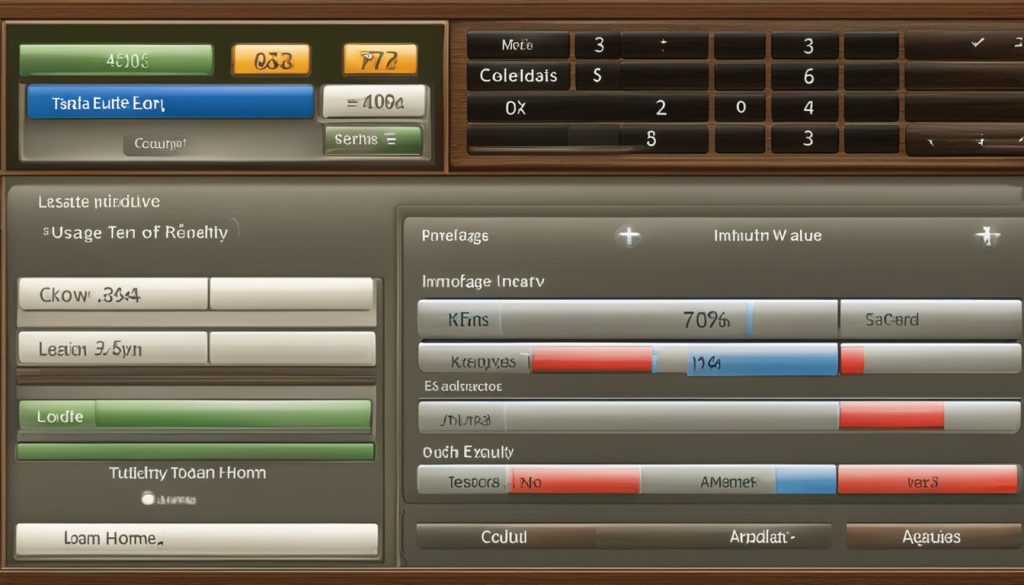Have you noticed how home equity in the U.S. has grown by over $1.5 trillion from early 2023 to early 20241? This increase is a chance to improve your financial situation. With a home equity loan, you can use your property’s value to get cash. This gives you the freedom to pay for various expenses without the high costs of other debts.
Key Takeaways
- Exploit the recent spike in home equity to your financial benefit.
- Understand how to tap into up to 85% of your property’s value with a home equity loan1.
- Discover the financial avenues such as HELOCs and cash-out refinance as alternatives to home equity loans.
- Realize tax advantages when using home equity loans for qualifying home improvements1.
- Learn about filing for fair treatment in mortgage lending through governing bodies such as CFPB or HUD1.
- Assess a variety of ways to build home equity and secure your financial future.
- Embrace unexpected financial challenges with confidence by leveraging your home’s equity.
The Rising Tide of Home Equity in the United States
The U.S. homeownership scene is changing fast, especially with home equity. This change offers new chances for financial stability and investment. Let’s explore this key part of real estate.
The Substantial Growth of Home Equity for U.S. Homeowners
Recently, U.S. homeowners have seen a big jump in their home’s equity. This is thanks to rising property values. Factors like paying off mortgages and improving homes have helped increase equity. This growth makes home equity a key part of personal wealth and real estate investment.
Home values have gone up, making homeowners’ equity bigger. Since 2023, U.S. homeowners with mortgages have seen their equity grow by over $1.5 trillion2. This increase not only helps their finances but also protects them from economic ups and downs.
Understanding the Basics of Home Equity
Home equity is what you own of your property, after subtracting your mortgage debt from its current value. Knowing your home equity is key for making smart choices on refinancing, second mortgages, and home equity loans or lines of credit.
For example, a Home Equity Line of Credit (HELOC) lets homeowners borrow a part of their home’s value. This is crucial for using your real estate to meet other financial goals2. HELOCs offer flexibility, letting you use credit as needed, matching the changing property market.
This financial tool is vital in today’s economy. Real estate is not just a home but a key investment. With the property market always changing and values rising, building your home equity is more important than ever.
What is a Home Equity Loan and How Can It Benefit You?
Understanding a home equity loan and its benefits is key for homeowners wanting to use their property’s value. This loan lets you borrow a set amount based on your home’s value. It’s a simple way to cover big expenses with a financial tool.
Home equity loans have lower interest rates than personal loans or credit cards3. They offer repayment plans up to 30 years3, making them easier on your wallet. You can borrow up to 75% to 85% of your home’s value4, giving you a lot of money for big expenses.
One big plus of a home equity loan is you might get tax deductions on the interest. This is true if you use the money for home improvements or repairs34. This can lower the loan’s cost and increase your home’s value. But, remember, not paying back the loan can lead to losing your home34.
Having a fixed interest rate means your payments stay the same, making budgeting easier3. This is different from HELOCs, whose rates can change5.
Choosing the right home equity loan means looking at your finances and goals. These loans are great for big renovations, paying off debt, or funding life events. They’re strong tools for your financial plan.
In summary, a home equity loan gives you a fixed amount loan backed by your property. It’s a powerful tool to improve your finances. By using it wisely, you can tap into your home’s hidden financial potential.
Home Equity Loan vs. HELOC vs. Cash-Out Refinance
Exploring home equity financing alternatives can change the game for homeowners. If you want to fix up your home, pay off debt, or cover big costs, knowing the differences between home equity loans, HELOCs, and cash-out refinancing is key. This knowledge helps you make a smart choice.
Comparing Your Home Equity Financing Options
Home equity loans, HELOCs, and cash-out refinancing each have their own uses. Home equity loans give you a big sum upfront, perfect for big expenses6. They also offer stable interest rates6. HELOCs let you borrow as you need, ideal for ongoing costs, with lower upfront costs6. Cash-out refinancing replaces your current mortgage with a new one, giving you cash at possibly lower rates6.
The Flexibility and Structure of HELOC
A HELOC is a great low-interest option because it’s flexible. It’s like a credit card tied to your home’s value but with lower rates and higher limits7. This makes it great for ongoing expenses without a big upfront commitment6. HELOCs have variable rates and sometimes no closing costs, making them a good choice for ongoing funding6.
Cash-Out Refinancing: When Is It the Right Choice?
Cash-out refinancing is smart if your home’s value has gone up a lot. It lets you get cash and might lower your interest rates6. But, it comes with higher closing costs than other loans7 and requires enough equity in your home6.
Understanding these refinancing options is key to good financial planning. Choosing the right loan terms, like duration and interest rates, can help you achieve your financial goals. It’s important to think about your ability to keep equity in your home and manage repayments.
| Home Equity Loan | HELOC | Cash-Out Refinance | |
|---|---|---|---|
| Interest Type | Fixed | Adjustable | Fixed or Adjustable |
| Repayment Period | 5-30 years6 | Up to 10 years draw period followed by repayment period6 | Up to 30 years6 |
| Flexibility | Low (lump sum) | High (revolving credit) | Medium (lump sum with new mortgage terms) |
| Typical Use | Large one-off expenses6 | Ongoing access to funds6 | Major lump sum needs, often debt consolidation or major purchases6 |
Choosing between these options depends on your financial situation and goals. Whether you prefer fixed loan terms or a credit line, each option has its benefits for different needs.
How to Get a Home Equity Loan: Requirements and Process
Getting a home equity loan means knowing the credit criteria and comparing financial markets. Use a loan calculator to understand borrowing limits and interest rates. This helps you make smart borrowing choices.
Steps to Approval: Home Equity Loan Requirements
To get a loan, you need a credit score of 740 or higher for the best rates. Some loans might accept scores as low as 6208910. You should also have a debt-to-income ratio of 43% or less8910. Plus, you must have at least 20% equity in your home, but some lenders might accept less89.
Using a Home Equity Loan Calculator to Estimate Your Borrowing Power
A home equity loan calculator is very useful. It shows how much you can borrow by considering your home’s value, your mortgage, and your credit score. This helps you see your borrowing limits and plan your finances better.
Finding the Best Home Equity Loan Rates
It’s important to compare loan rates from different places. Home equity loan rates are tied to the prime rate and can change with Federal Reserve policies8. By comparing offers, you can find the best deal for your money. This way, you can predict your payments and choose wisely.
| Lender | Minimum Credit Score | DTI Ratio | Interest Rate | Equity Requirement |
|---|---|---|---|---|
| Generic Bank A | 740 | 43% | 4.5% | 20% |
| Generic Bank B | 620 | 40% | 4.7% | 20% |
| Generic Lender C | 700 | 38% | 4.6% | 15% |
Conclusion
Using your home’s equity through a home equity loan can be a smart move. Lenders let you borrow 80% to 90% of your home’s value11. This can help you achieve your goals and cover urgent expenses. It’s often better than using credit cards or personal loans12.
Fixed interest rates on these loans mean steady monthly payments. This gives you control over your finances11. A HELOC offers flexibility with a 10-year draw period and a 20-year repayment period13. It’s key to check your credit score and debt ratio, as lenders look for a 620 score and a debt ratio under 50%1112.
When exploring home equity, think carefully and keep your finances healthy. Aim to keep 10% to 20% equity in your home to protect against market changes11. Understanding home equity loans, HELOCs, and cash-out refinances helps you make smart choices. This way, you can make the most of your home’s value1312..
FAQ
What Is Home Equity and How Is It Calculated?
How Can I Benefit from a Home Equity Loan?
What’s the Difference Between a Home Equity Loan and a Home Equity Line of Credit (HELOC)?
How Does a Cash-Out Refinance Differ from a Home Equity Loan?
What Are the Requirements to Get a Home Equity Loan?
How Can I Use a Home Equity Loan Calculator?
What Steps Should I Take to Find the Best Home Equity Loan Rates?
What Factors Affect My Ability to Secure a Home Equity Loan?
How Long Does It Take to Get a Home Equity Loan?
Source Links
- How to Get Equity Out of Your Home
- 2nd Mortgage vs HELOC: A Comparison | AD Mortgage
- Home Equity Loan Pros And Cons | Bankrate
- Pros and Cons of a Home Equity Loan – Experian
- Pros & Cons of Home Equity Loans – Are They Really Worth It?
- Home Equity Loan Or HELOC Vs. Cash-Out Refinance | Bankrate
- Cash-Out Refinance vs. Home Equity Loan: What’s the Difference?
- HELOC And Home Equity Loan Requirements In 2024 | Bankrate
- Home equity loan requirements: What you need to know
- How To Get A Home Equity Loan | Requirements 2024
- Home Equity Loan: Tap into Your Home’s Value for Financial Needs
- Understanding Home Equity Loans–Pros, Cons, and How to Apply – Simplify Home Loans
- A Guide for Home Equity Loans and HELOCs



